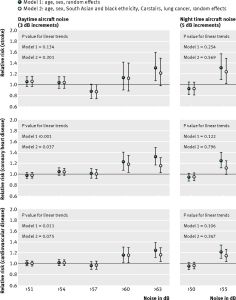Science and Health
Screaming for Quiet: Germans Crank Up Anti-Noise Protests, October 4, 2013, http://www.spiegel.de/international/germany/noise-pollution-protests-increase-in-germany-a-925806-2.html
Aircraft noise linked with heart problems, October 8, 2013
http://www.hsph.harvard.edu/news/press-releases/aircraft-noise-linked-with-heart-problems/
Residential exposure to aircraft noise and hospital admissions for cardiovascular diseases: multi-airport retrospective study, October 8, 2013, British Medical Journal. (research was conducted in America and partially funded by the FAA) http://www.bmj.com/content/347/bmj.f5561
Health Consequences of Aircraft Noise, August 4, 2008, Deutsches Arzteblatt International
http://www.ncbi.nlm.nih.gov/pmc/articles/PMC2696954/
Does traffic-related air pollution explain associations of aircraft and road traffic noise exposure on children’s health and cognition? A secondary analysis of the United Kingdom sample from the RANCH project, July 25, 2012, American Journal of Epidemiology
http://www.ncbi.nlm.nih.gov/pubmed/22842719
Exposure-effect relations between aircraft and road traffic noise exposure at school and reading comprehension: the RANCH project, November 23, 2005, American Journal of Epidemiology.
http://www.ncbi.nlm.nih.gov/pubmed/16306314
The effects of chronic aircraft noise exposure on children’s cognition and health: 3 field studies, April-June 2003,
http://www.ncbi.nlm.nih.gov/pubmed/12804210
Aircraft and road traffic noise and children’s cognition and health: a cross-national study, June 4, 2005, The Lancet.
http://www.ncbi.nlm.nih.gov/pubmed/15936421
The American Public Health Association Policy Statement on Environmental Noise Pollution Control
Policy Number 20135, Nov 05 2013 (read entire statement here)
Unwanted and disturbing sound increases the risk for a variety of negative health outcomes such as heart disease, diabetes, hypertension, hearing loss, and sleep disturbance. While current federal and local policy is fragmented, the infrastructure for greater collaboration is available and ready to be utilized to improve public health outcomes. The American Public Health Association should archive the policy statement on noise from 1975 and advocate for the implementation of a federal noise control plan through the United States National Prevention Strategy. Federal leadership in noise monitoring, research, and education will help local governments abate the negative health outcomes associated with environmental noise pollution.
Reduction in Environmental Noise May Reduce the Incidence of Heart Disease
A statistical study appeared in the American Journal of Preventative Medicine suggesting that a 5 dB reduction in environmental noise will reduce the incidence of hypertension by 1.4% and coronary artery disease by 1.8%. This would result in a net saving of $324B of health care expenditure.
A World Health Organization document that provides evidence that supports the establishment of a 55 dBA community noise standard (the European standard). The United States is currently more tolerant of noise pollution with a threshold of 65 dBA.
WHO Guidelines for Community Noise
They also explain the adverse effects of sleep disturbance induced by exposure to sounds louder than 45 dB.
On Drones
The FAA is an anticipating increased drone traffic (unclear what the drones will be watching). As they proliferate, there may well be conflicts with commercial aircraft. Ames is working on a system which will coordinate drone traffic with commercial traffic. If the commercial flights are moved into narrow corridors, this will make more space for the drones.
Relative Intensities of Common Noises
| Sound | dBA |
|---|---|
| Rustling leaves | 20 |
| Room in a quiet dwelling at midnight | 32 |
| Soft whispers at 5 feet | 34 |
| Men's clothing department of large store | 53 |
| Window air conditioner | 55 |
| Conversational speech | 60 |
| Household department of large store | 62 |
| Busy restaurant | 65 |
| Typing pool (9 typewriters in use) | 65 |
| Vacuum cleaner in private residence (at 10 feet) | 69 |
| Ringing alarm clock (at 2 feet) | 80 |
| Loudly reproduced orchestral music in large room | 82 |
| Printing press plant | 86 |
| Heavy city traffic | 92 |
| Heavy diesel-propelled vehicle (about 25 feet away) | 92 |
| Air grinder | 95 |
| Cut-off saw | 97 |
| Home lawn mower | 98 |
| Turbine condenser | 98 |
| 150 cubic foot air compressor | 100 |
| Banging of steel plate | 104 |
| Air hammer | 107 |
| Jet airliner (500 feet overhead) | 115 |
Hearing damage starts to occur with prolonged exposure to sounds >85 dBA.
Taken from Aviation Noise Effects (1985), NTIS Document FAA-EE-85-2
A readable publication done by the FAA at a different time, describing the metrics used in noise measurements and some of the earlier studies done on annoyance with loud sounds. An excellent introduction to the topic.
High levels of noise around airports are associated with a graded, statistically significant increase in hospitalization and death from heart disease and stroke.
The British Medical Journal recently published an article showing statistically significant increases of up to 21% in the rate of hospital admission and mortality with increasing amounts of aircraft noise. The effect seemed more associated with nighttime noise than with daytime noise and was stronger in people of South Asian and black ethnicity. While association is not proof of cause and effect, the relationship is concerning.
This shows the relative risks (95% confidence intervals) for associations between mortality from stroke, coronary heart disease, and cardiovascular disease in 2001-05 and annual population weighted average daytime aircraft noise (relative to ≤51 dB) and night time aircraft noise (relative to ≤50 dB) in 2001. The FAA cutoff for dangerous aircraft noise is 65 dB, higher than this study considers. (AL Hansel, et al., BMJ 2013;347:f5432)

